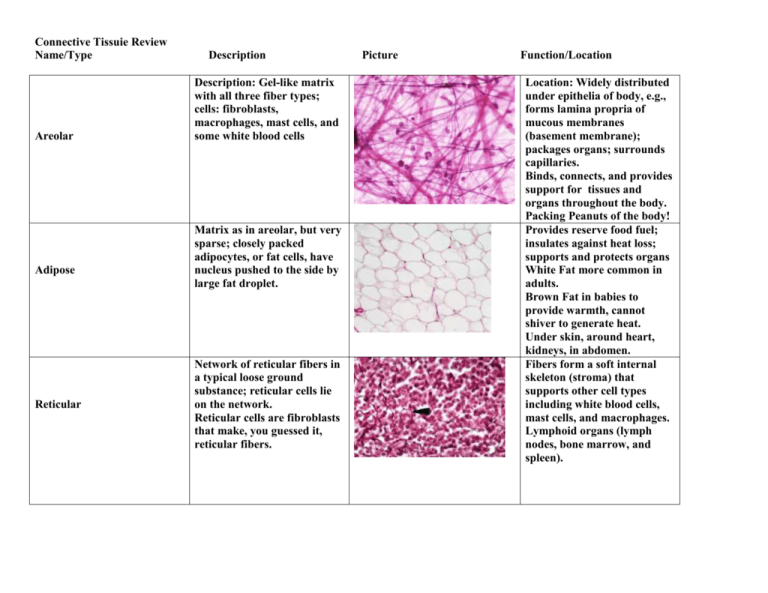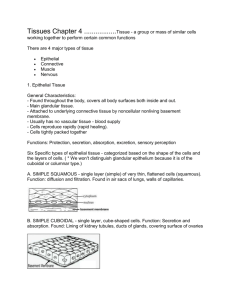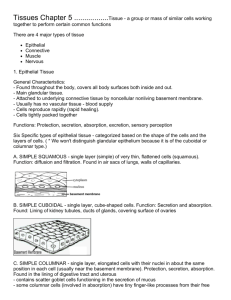Connective Tissue Review: Types, Functions, & Locations
advertisement

Connective Tissuie Review Name/Type Areolar Adipose Reticular Description Description: Gel-like matrix with all three fiber types; cells: fibroblasts, macrophages, mast cells, and some white blood cells Matrix as in areolar, but very sparse; closely packed adipocytes, or fat cells, have nucleus pushed to the side by large fat droplet. Network of reticular fibers in a typical loose ground substance; reticular cells lie on the network. Reticular cells are fibroblasts that make, you guessed it, reticular fibers. Picture Function/Location Location: Widely distributed under epithelia of body, e.g., forms lamina propria of mucous membranes (basement membrane); packages organs; surrounds capillaries. Binds, connects, and provides support for tissues and organs throughout the body. Packing Peanuts of the body! Provides reserve food fuel; insulates against heat loss; supports and protects organs White Fat more common in adults. Brown Fat in babies to provide warmth, cannot shiver to generate heat. Under skin, around heart, kidneys, in abdomen. Fibers form a soft internal skeleton (stroma) that supports other cell types including white blood cells, mast cells, and macrophages. Lymphoid organs (lymph nodes, bone marrow, and spleen). Name/Type Description Picture Function/Locations Primarily parallel collagen fibers; a few elastic fibers; major cell type is the fibroblast. Mostly cells, poorly vascularized. Great Tensile strength, when pulling force is applied in one direction. Paper Towel Fiber Demo Attaches muscles to bones or to muscles; attaches bones to bones; Tendons Most Ligaments Aponeuroses . Dense Irregular Primarily irregularly arranged collagen fibers; some elastic fibers; fibroblast is the major cell type. Withstands tension exerted in many directions; provides structural strength. Fibrous capsules of organs and of joints; dermis of the skin; submucosa of digestive tract Elastic CT Dense regular connective tissue containing a high proportion of elastic fiber Elastic Rubber Band demo Walls of large arteries; within certain ligaments associated with the vertebral column; within the walls of the bronchial tubes Allows tissue to recoik; blood flow through arteries; aids in recoil of bronchial tubes Dense Regular Supports and reinforces; serves as resilient cushion; resists compressive stress. Forms embryonic skeleton Nose Trachea Costal Cartilage of ribs Hyaline Cartilage Elastic Cartilage Fibrocartilage Amorphous but firm matrix; collagen fibers form an imperceptible network; chondroblasts produce the matrix and when mature (chondrocytes) lie in lacunae maintain the matrix. Avascular Lack nerves Tough yet flexible End of long bones at joints, most common type of cartilage. Similar to hyaline cartilage, but more elastic fibers in matrix. In general more chondrocytes than hyaline. Maintains the shape of a structure while allowing great flexibility. Ear Epiglottis Matrix similar to but less firm than that in hyaline cartilage; thick collagen fibers predominate. Sort of a cross between dense regular and hyaline cartilage. Find something on the internet. Google it. Check the website later. Bring in a picture for a bonus point. Tensile strength allows it to absorb compressive shock. The shock absorbers of the body and thus found in the intervertebral discs (between the backbones) in the knee joint, and the pubic symphysis joining the hip bones. Connective Tissuie Review Name/Type Bone Blood Description Picture Function/Locations Hard, calcified matrix containing many collagen fibers; osteocytes lie in lacunae. Very well vascularized. Support, protect, and work with muscles for movement. Produce red blood cells to in its marrow! Well, bones! Throughout the skeletal system. Red and white blood cells in a fluid matrix (plasma). Lacks fibers. WBC’s (purple/blue cells) RBC’s (well, red more numerous) Transport respiratory gases, nutrients, wastes, and other substances. Special Type of CT Fluid Group Found within blood vessels throughout the body.











